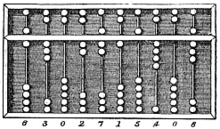Calculus


Calculus ( Latin calculus , diminutive of calx , ( pebble ) stone, plural: calculi ) Origin: from Latin, literally "small pebble" (used as a calculating stone , for example in an abacus).
The advent of the temple economy led in advance of the civilization development of imaging speeds and tools that facilitate computing. The calculi or tokens are small stones, later pieces of clay with engraved geometric symbols, which were used, for example, in the high cultures of Mesopotamia as an aid for accounting for deliveries of goods.
history
The first aids for processing things, goods and numbers were certainly the ten fingers of people's hands. From this point of view, it can be explained that still early advanced civilizations worked with both five-number systems ( Greeks , Romans , Maya , Chinese ) and with systems of ten ( Egyptians , Sumerians and Babylonians ). Tokens are used in the settlements of the Middle East from the 8000 to 3000 BC period. Found. About 5200 years ago a script was developed by the Sumerians in southern Mesopotamia (independently of that, at about the same time in Egypt) . It consisted of over a thousand characters. About sixty of them can be seen as precursors to the later numbers. In this proto-cuneiform script, as the archaic form of cuneiform script is called, around 5000 clay tablets and tablet fragments have survived, most of them from Uruk .
Even before writing was developed, the expressive possibilities of this aid were expanded by assigning numerical values to certain forms of tokens. A conical counting stone can have the numerical value “1”, a ball the value “10” and a large conical piece of clay the value “60”. Another possibility is that the shape denoted certain goods or staple foods (such as a certain amount of grain). Tokens are also found at the same time as the appearance of writing and some of the tokens are similar in shape or drawing to the characters, which made it possible to interpret them as a specific number. Undoubtedly, the tokens were the earliest trading control systems. However, they were only able to record aspects such as the amount and type of objects (e.g. loaves of bread, skins, oil jugs).
In order to ensure that the recipient received a delivery in full during trading transactions, the seller could pack the appropriate type and number of tokens in a hollow clay ball. This was closed and sealed with fresh clay. A kind of “waybill” was invented and the recipient could check whether the caravan driver had delivered everything that his trading partner had sent.
Another type of token, reminiscent of cylinder seals and also known as "tablets", comes from the Indus culture , is made of terracotta and was found in Harappa . However, it is not clear whether they also embody numbers.
use
The Greeks and Romans used calculi when calculating with the abacus or when calculating on lines . The words "calculate" and " calculus " are derived from the Latin term . In the Middle Ages, calculating stones were also used as embossed calculating pennies .
See also
- "Calculus" is the English term for infinitesimal calculus
Web links
literature
- Denise Schmandt-Besserat : How Writing Came About. University of Texas Press 1996, ISBN 978-0-292-77704-0
- Denise Schmandt-Besserat: From the origin of writing. In: Spektrum der Wissenschaft, 12/1978, pp. 4-13
Individual evidence
- ^ Karl Ernst Georges: Comprehensive Latin-German concise dictionary . Ed .: Karl-Maria Guth. New sentence of the 8th edition from 1913. Volume 2 (CD). BoD - Books on Demand, Berlin 2014, ISBN 978-3-8430-4919-1 , pp. 612 ( zeno.org ).
- ↑ Denise Schmandt-Besserat: From the origin of writing.
